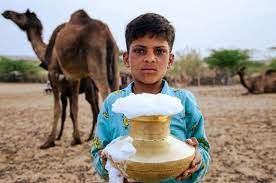Camel Rearing Practices : A Sustainable Livelihood of Desert Ecosystem in India
Camel in Indian context is considered as an integral partof desert eco-system and existence of camel in other parts ofthis country is largely not known where it is sustaining mainlydue to its milk (Mehta and Sahani 2004). Camel milk is beingutilized to a great extent in the south and south-easterndistricts of Rajasthan and adjacent Madhya Pradesh. Mewaribreed of camel is prevalent in these regions. The breed isadapted to the hilly terrains of Arawali hills of southRajasthan and is one among the four major breeds of camelin India (Rathore 1986, Khanna et al.2004, Mehta et al.2007). The camel milk is three-time richer in vitamin C (Farahet al. 1992) and rich in iron, zinc, copper, sodium,magnesium, manganese and potassium (Sawaya et al. 1984,Abu-Lehia 1987) and low in lactose (Elamin and Wilcox1992) as compared to the cattle milk. Recently much attentionhas been paid on the utilization of the inherent properties ofcamel milk for human health (Gorakhmal et al. 2000, 2001,Sahani et al. 2005) but the milk production potential of thespecies remains largely unexplored. This study was thereforefocused to document the actual production and sale of camelmilk in this country, to discuss the shift of selection criteriafrom draught to milk and to explore the possible contributionof breeding camels for milk production in in situ conservationof the species.
Camel (Camelus dromedaries) is a domesticated milk yielding animal and generally exists in the desert area, since their body physiology helps them to adapt in arid and semi-arid zones. It is a multipurpose animal used for production (milk, meat, wool, skin, manure), leisure (sports like racing and polo, tourism, beauty contests, festivals), transport (riding, carting, pack carrying) or agricultural work (ploughing, weeding, harrowing, water extraction) from ancient period. This one humped camel breeds, Indigenous to India, have been shown to have good genetic potential to produce milk. Camels are mainly confined to the States of Rajasthan, Gujarat, Haryana, and Uttar Pradesh in India. The total Camel population in the country is 2.5 Lakhs (0.25 million) in 2019, decreased by 37.1% over previous Census (2012). The Rajasthan with Camel population of around 2.13 Lakhs ranks first in India, although Camel population is also decreased by 34.69% over previous census (2012) in the state (20th Livestock Census, 2019, DAHD). Camel is the iconic animal of Rajasthan. It is a part of the cultural identity & life of the desert state. In 2014, Camel (Camelus dromedaries) has been declared as the State Animal (Livestock) of Rajasthan supporting about 85 per cent of India’s camel population. The iconic animal of Rajasthan, ‘The ship of desert” is now combating for its survival. Major reduction in the camel population has been observed during the last two decades. The main reasons for the continuous decline in camel population in India are significant reduction in the traditional use of camels for draft purpose, transport of goods and agricultural operation due to automation and better transport facilities. The shrinkage of rangelands is one of the most important causes, contributing in dwindling of camel population. Other causes are the increasing trend in adoption of intensive agricultural practices for cash crops due to the availability of canal water in the Thar Desert in the recent past and emergence of new camel diseases, such as camel pox, due to change in the climatic conditions mainly rise in humidity. Camels are less likely to survive as milch animals despite many demonstrated benefits of camel milk due to several reasons i.e. long gestation period (14-16 months); limited saleable yield (less than 5 kg a day), high cost of maintenance, the subsequent high cost of milk and the strong flavour of camel milk which is not generally not liked by humans. When the camel was declared a state animal and The Rajasthan Camel (Prohibition of Slaughter and Regulation of Temporary Migration or Export) Act, 2015 came into effect, the camel herders expected to save their camels but has had just the opposite effects. This Act safeguards camels from slaughter by banning their export, transportation or breeding but it continues illegally. Therefore, their utility for camel herders has declined much and they are trying to get rid of their herds by illegally selling them to slaughter houses as they neither have any means to feed or take care of the camels. The Camel Act has led to a dramatic fall in camel trade at the various livestock fairs eg. Pushkar cattle fair and prices of camels have dropped by 80-90% from the price that they would fetch earlier, leading to monetary loss to the camel breeders.
The Raika/ Rabari community are pastoralists and have been known to herd camels for a livelihood for centuries. However, now their source of sustenance is at risk. The population of the camel in Rajasthan is sharply dwindling and essential measures should be taken for restricting it to come under endangered category. The key to arresting the decline is diversification, secure, establish and maintain camel grazing areas. Other important protective measures should be adopted like establishment of a market/dairy and investment in value addition or processing of raw camel milk, increase the awareness regarding utilization of camel milk as health adjuvant to enhance its production and demand. Camel milk is known to have unique properties of its proteins, fatty acids, richer in microminerals and vitamin C as compared to milk of other animal species and can be used as an alternative of human milk due to its nutritional values and medicinal properties. Hence, there is also the need to showcase camel products and create economic and social space for camel milk and its products for the upliftment of socio-economic status of Raika’s/ Rebari’s. Establishment of sanctuaries for preserving camels, funding by the government or proper implementation of camel development and insurance schemes and amendments in the existing camel related acts/rules are mandatory efforts by which we can harvest handsome returns in terms of enhancement in Camel population.
Importance of camel milk
Camels are known for their ability to produce milk, in comparison to other species of Camelidae. Milk production from camels is mainly practiced in pastoral migratory systems but the intensive camel dairy farming is increasing in many countries. Dairy camels can be classified into three groups, high, medium, and low, based on their milk production. Only the high and medium milk-producing camels can be considered as true dairy camel types. Lactation length varies from 6 to 18 months. Infection by bacterial or mycotic pathogens is the main cause of mastitis. Socioeconomic constraints, longer calving interval, and hand milking hinder progress in improving milk production. Camel milk production from intensive systems has started to become a reality, and has shown promising results. The peak of lactation in camels tends to decline more steeply than in dairy cows; nevertheless, camels are much better providers of high-quality protein than cows, sheep, and goats to the people living in the arid and semiarid areas. The gross composition of camel milk is similar to that of cattle and goat milk but high differences were described in the fine composition (fatty acids, vitamins, type of proteins). Camel milk is generally opaque white and low in carotene. It has a sweet and sharp taste, but sometimes can also be salty. Most of the camel milk is consumed as fresh milk. However, surplus milk is processed into naturally fermented products. Camel milk is one of the most valuable food resources for the people living in arid and semiarid zones. Most of the camel milk is consumed as fresh milk. One of the oldest ways of consumption of surplus of camel milk is its fermented form. The diversity of fermented camel milk products in the world is extraordinarily rich. Each camel milk producer region had his own varieties of fermented camel milk with their specific taste, texture and flavor. Nowadays each camel country describes their traditional fermented milk by microbiological, physico-chemical, chemical properties.
Camel is referred as “ship of desert”. It can survive in dry desert with prominent water and fodder scarcity and prevalent harsh weather conditions. Camels are found in arid and semi-arid climates of India i.e. Bikaner and Jaisalmer districts of Rajasthan and Kutch district of Gujarat. Camel rearing in India was mainly reflects the rich heritage of India. Camel race during Puskar mela at Bikaner, Rajasthan pulls and piles visitors for fun through run ceremony. Camel raising was also associated with certain cultural taboos. People here did not sell the milk, meat and wool of camel; even they never sell the female camel. The major profit making aspect of camel i.e. transportation and draft use is no more valued in India due to advent of innovative and affordable technologies. The livestock census of India shows a dramatic declining trend in their population (37% over previous census). Now this is a major challenge for nomads, government and veterinarians to find a purpose to rear this desert animal. In these changing circumstances, news came during corona lockdown period that a special train delivered camel milk powder from Rajasthan to Odisha for a desperate autistic child. So a complete understanding of this underrated livestock is needed from different angle of production and marketing.
In India important camel breeds, viz. Bikaneri, Jaisalmeri, Kachhchi and Mewari, are shown to produce 3105–4190 kg milk per lactation at the rate varying from 3.8 to 10.8 kg/day. Under the umbrella of food and nutrition security, camel milk is emerging as efficient functional food. People have been searching for natural foods with health benefits instead of medications which have numerous side effects. Camel milk is also known as the “white gold”. Food and Agriculture Organization (FAO) in 2006 stated that there is bright future of camel milk. It is a nutrient dense, inexpensive and easily available food for camel rearers and some specific consumers. Its nutrient richness is unquestionable and uncountable. It is the best natural diet containing diverse micronutrients including vitamin A, vitamin B12, riboflavin, calcium, iron and zinc that are essential for proper growth and development of human body.
In several regions of Iran, Pakistan and India, camel milk has long been used therapeutically against dropsy, jaundice, spleen and liver complexities, stomach and intestinal disorders, infant diarrhea, tuberculosis, vitamin inadequacy, diabetes-1, food allergy, asthma, anemia, and piles. In addition, camel milk has been also used to reduce cholesterol levels in the blood, to soothe psoriasis disease, to heal inflammation in the body, to help in strengthening the immune system and to reduce the growth of cancer cells. It is used as a natural remedy for diabetes for centuries. It is also helpful for children having allergy with cow milk and even initial research findings prove its role in treatment of autism in children. On 29th November, 2016, the Food Safety and Standards Authority of India (FSSAI) has approved camel milk for the sale purposes. It was a good news for the camel rearers and camel milk entrepreneurs. Presently, camel milk with different value added products are available only at NRCC dairy booth in Bikaner city. Indian milk cooperative Amul for the first time has launched camel milk in Gujarat markets. Amul Camel Milk is marketed at 50 rupees for 500ml pet packet which has a shelf life of three days in refrigerated condition. Camel milk marches a long journey to find its customers either through a brand like Amul or through any e-commerce channels like Flipkart.
Government may promote many more FPOs (Farmers Producer Organizations) among these communities and create a best platform for camel rearing, breeding, production and market both at national and international spheres. In a nutshell, life always starts from a scratch, and opportunity in disguise repeats many times. Unique Camel milk as production and marketing definitely creates its own segments in near future.
Compiled & Shared by- Team, LITD (Livestock Institute of Training & Development)
Image-Courtesy-Google
Reference-On Request.
Sustainable Camel Farming in India

Sustainable Camel Farming in India _compressed


